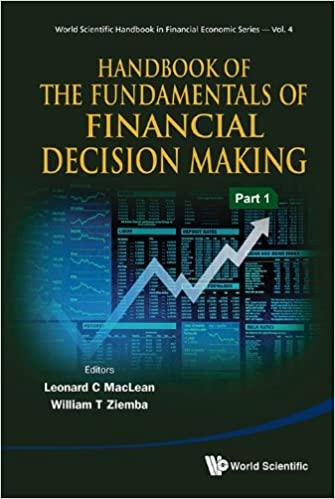Question
Liverpool FC Fan Club Inc.'s capital situation is described as follows: Debt: The firm issued 10000 25-year bonds 10 years ago at their par value
Liverpool FC Fan Club Inc.'s capital situation is described as follows: Debt: The firm issued 10000 25-year bonds 10 years ago at their par value of $1000. The bonds carry a coupon rate of 14% and are now selling to yield 10%. Preferred Stock: 30,000 shares of preferred stock were sold 6 years ago at a par value of $50. The shares pay a dividend of $6 per year. Similar preferred issues are now yielding 9%. Equity: Liverpool was initially financed by selling 2 million shares of common stock at $12. Accumulated retained earnings are now $5 million. The stock is currently selling at $13.25. Liverpool's target capital structure is as follows. Debt 30% Preferred Stock 5 Common Equity 65 100% Other information: Liverpool's marginal tax rate (state and federal) is 38%. Flotation costs average 10% for common and preferred stock. Short-term Treasury bills currently yield 7.5%. The market is returning 12.5%. Liverpool's beta is 1.2. The firm is expected to grow at 6% indefinitely. The last annual dividend paid was $1.00 per share. Liverpool expects to earn $5 million next year. The firm can borrow an additional $2 million at rates similar to the market return on its old debt. Beyond that, lenders are expected to demand returns in the neighborhood of 14%. Liverpool has the following capital budgeting projects under consideration in the coming year. These represent its investment opportunity schedule (IOS). Capital Cumulative Project IRR Required Capital Required A 15% $3 million $3 million B 14 2 million 5 million C 13 2 million 7 million D 12 2 million 9 million E 11 2 million 11 million Calculate the firm's capital structure based on book and market values, and compare with the target capital structure. Round the values to the nearest dollar and round the weights to two decimal places of percentage. Do not round your intermediate calculations. Enter numbers only: don't include "$" or "%". Book Market Value Weights Value Weights Target Weights Debt $ % $ % 30% Preferred $ % $ % 5 Equity $ % $ % 65 $ 100% $ 100% 100% Calculate the cost of debt based on the market return on the company's existing bonds. Round the answer to two decimal places. Enter numbers only; do not include the "%". % Calculate the cost of preferred stock based on the market return on the company's existing preferred stock. Round the answer to two decimal places. Enter numbers only; do not include the "%". % Calculate the cost of retained earnings using three approaches: CAPM, dividend growth, and risk premium. Reconcile the results into a single estimate. Round the answer to the nearest whole percentage. Do not round your intermediate calculations. Enter numbers only; do not include the "%". % Estimate the cost of equity raised through the sale of new stock using the dividend growth approach. Round the answer to two decimal places. Do not round your intermediate calculations. Enter numbers only; do not include the "%". % Calculate the WACC by using equity from retained earnings based on your component cost estimates and the target capital structure. Round the answer to two decimal places. Do not round your intermediate calculations. Enter numbers only; do not include the "%". % Where is the first breakpoint in the MCC (the point where retained earnings run out)? Enter your answer in millions. For example, an answer of $1.2 million should be entered as 1.2, not 1200000. Round your answer to one decimal place. Do not round your intermediate calculations. Enter numbers only; do not include the "$". $ million Calculate the WACC after the first breakpoint. Round the answer to two decimal places. Do not round your intermediate calculations. Enter numbers only; do not include the "%". %
Step by Step Solution
There are 3 Steps involved in it
Step: 1

Get Instant Access to Expert-Tailored Solutions
See step-by-step solutions with expert insights and AI powered tools for academic success
Step: 2

Step: 3

Ace Your Homework with AI
Get the answers you need in no time with our AI-driven, step-by-step assistance
Get Started


